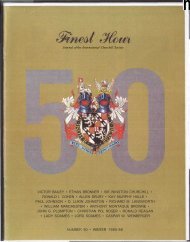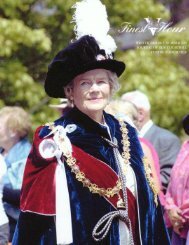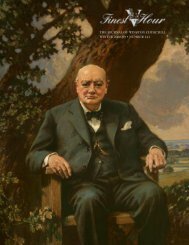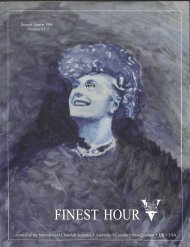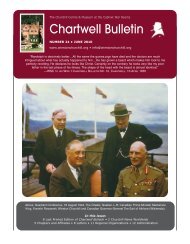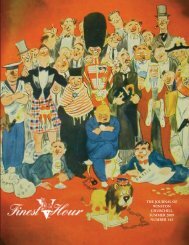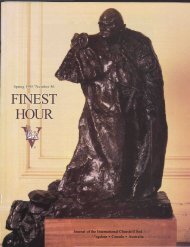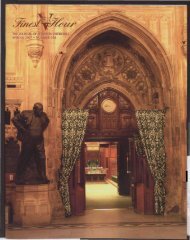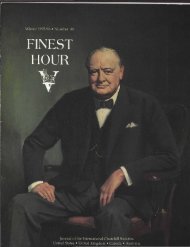SPRING 2006 ⢠NUMBER 130 - Winston Churchill
SPRING 2006 ⢠NUMBER 130 - Winston Churchill
SPRING 2006 ⢠NUMBER 130 - Winston Churchill
- No tags were found...
Create successful ePaper yourself
Turn your PDF publications into a flip-book with our unique Google optimized e-Paper software.
trade from Lloyd George, to 1940,when the older man refused WSC’srepeated entreaties for him to join hiscoalition government. Perhaps LloydGeorge was unwilling to work with<strong>Churchill</strong> (or Chamberlain), feelingthat their differing attitudes to theprosecution of the war would makedisagreement inevitable. Or perhaps, asthe author speculates, it was that, withdeclining powers in his old age, theWelsh Wizard did not want to “playsecond fiddle” to his old protege.The book argues that <strong>Churchill</strong>was not the born war leader, but hadto learn how to be one from LloydGeorge in World War I. The metamorphosistook years: it was arguably onlyin 1940 that <strong>Churchill</strong> emerged fromunder the shade of his mentor.The author, a member of ICS UK,does not shy away from Lloyd Georgethe cynical politician, and contraststhis with <strong>Churchill</strong>’s romantic view oflife and of their friendship. But it isquite clear from this book that LloydGeorge’s feelings for <strong>Churchill</strong> includedgenuine warmth. Sometimes therewas exasperation, sometimes embarrassment,but always admiration forhis talents and his humour.Perhaps most interestingly, thebook demonstrates one of the oftenoverlooked factors in <strong>Churchill</strong>’s rise topower in the summer of 1940. LeoAmery’s dramatic intervention in theNorway debate—quoting Cromwell toChamberlain, “In the name of God,go!”—is often quoted. Lloyd George’sspeech is much less referred to, butperhaps more decisive. It was the latter’sdevastating condemnation ofChamberlain’s administration, and hiswell-received remark that <strong>Churchill</strong>’sloyalty to Chamberlain should notallow him to serve as an “air-raid shelter”to protect his colleagues, that gave<strong>Churchill</strong> authoritative backing. It alsogranted <strong>Churchill</strong> at least tacit absolutionfrom responsibility for theNorwegian campaign (arguably anotherDardanelles), making <strong>Churchill</strong>’srise over Halifax the more certain.<strong>Churchill</strong> may have been LloydGeorge’s faithful follower, but the loyaltywas amply repaid.Unfortunately, the book makessome of the regular mistakes whenauthors ignore more recent research.Lord Randolph, we are told “may havecontracted syphilis”; although Sir<strong>Winston</strong> himself believed this, thediagnoses has since been proven highlyunlikely. <strong>Churchill</strong> is presented as havinghad Iroquois blood, whilst thestatement, “it is now recognised that<strong>Churchill</strong> was probably dyslexic,” isgiven without argument, source orqualification. These are, however,minor quibbles in a book that is wellresearched, evidenced and supported,and with a wealth of new family documentsand photographs.There are some gaps in the book’scoverage which are a shame in whatmust become the standard work onthe relationship. For example, thebook denies that, despite LloydGeorge’s pessimism over Britain’s abilityto win World War II, he was prepared,as is often asserted, to act as a“last card” in dealing with Hitler. Butfew examples are given in supportingLloyd George’s quoted patriotism andsupport for <strong>Churchill</strong> in private. Thisis a missed opportunity to end a sluron Lloyd George’s reputation whichcasts him, unjustifiably, as an oppositeto his friend <strong>Churchill</strong> in the definingmoment of 20th Century British history:defiance of Hitler.This book claims in its introductionto explore the relationshipbetween the two men in new light.This it brilliantly succeeds in doing. Itis certainly a book for which studentsof <strong>Churchill</strong> have been waiting forsome time. ,A R T SToast EtiquetteGET IT RIGHT! Since all responsible authorities agree onwhen and how to toast—why not do them properly?BY RICHARD M. LANGWORTHA<strong>Churchill</strong> Centre organizer writes:“Is there any set protocol for thetoast on Sir <strong>Winston</strong>’s birthday that weshould be aware of? We would like todo it the proper way.”Bless you for asking, Sir! Havingrecently had an earful from a distinguishedpersonage on what not to do,we are ready with the answers.Remember: there will be a quiz.First and foremost, from “TheEtiquette of Loyal Toasts”(http://xrl.us/ikix): “The Loyal Toast isproposed after dessert and coffee are served.”SEQUENCE OF TOASTSThere is, of course, a distinctionbetween the Loyal Toast(s) and othertoasts, including to Sir <strong>Winston</strong>’smemory. If there are no Loyal Toastsand the only toast being proposed is toWSC’s memory, that can be done anytime after coffee, and is sometimesoffered by a speaker after a speech, as awrap-up to the evening. In Britain, anon-loyal toast is usually a minispeech,as at a wedding by the BestMan, or brief remarks at a <strong>Churchill</strong>dinner. See: http://xrl.us/ikji.TOAST PROTOCOLThe following is confirmed withChristopher Hebb in Vancouver, andPaul Courtenay in England, who offersa variation, which is noted opposite.1) Do nothing until the waitershave served dessert/coffee and clearedout, making sure that they do notFINEST HOUR <strong>130</strong> / 43



